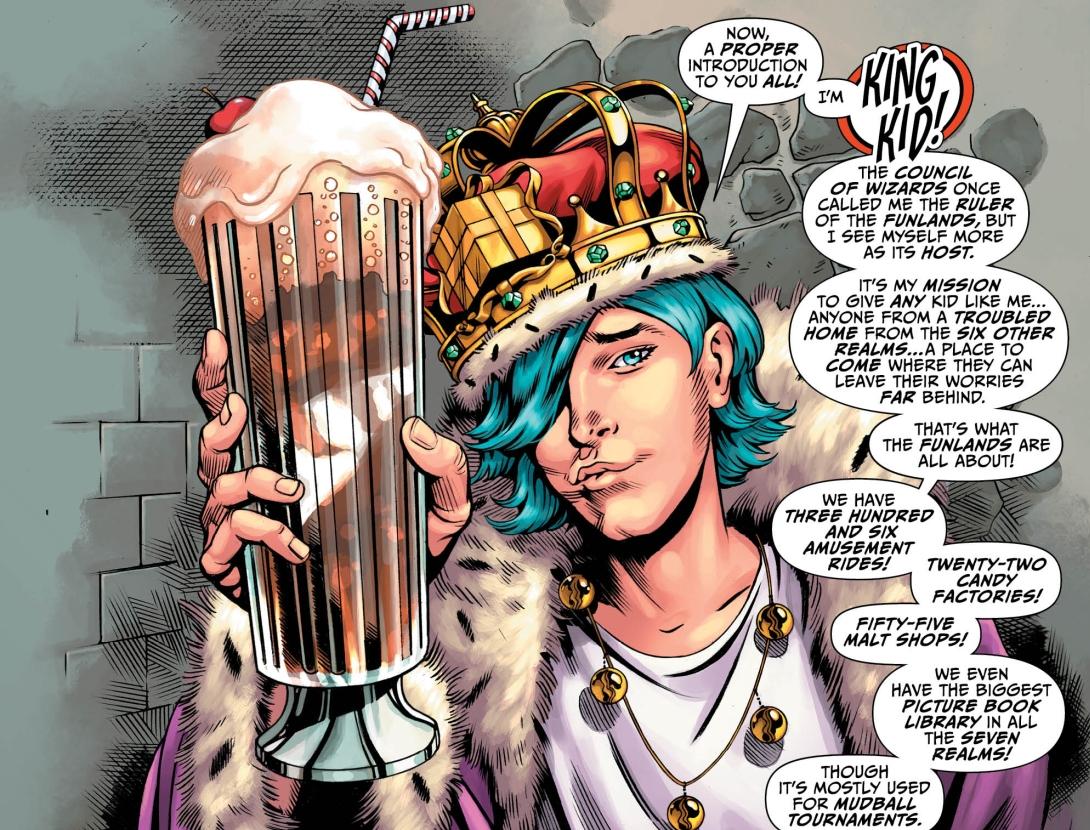[Editor’s Note: This review may contain spoilers]
Writer: Geoff Johns
Artists: Dale Eaglesham, Marco Santucci, Mayo “Sen” Naito
Letters: Rob Leigh
Reviewed By: Derek McNeil
Summary
“Shazam And The Seven Realms” continues! Billy Batson’s world is turned upside down by a figure from the past while Mary, Freddy and the rest of the Shazam Family enter a realm of endless amusements, candy factories and friends in the Funlands! But what’s the catch? Plus, a shocking development within the Library of Eternity!
Positives
The story continues with the Shazam family enjoying themselves in the realm of Kid King. Kid attempts to convince them that he was intended to be the seventh member of the family. However, Mary is the only one that seems to be the only one that has suspicions about Kid King and his realm.
Johns seems to be drawing on some classic children’s stories here. Kid King’s Funlands are clearly based on Pinocchio’s Pleasure Island, which was also a land offering to indulge every child’s fantasy, but had a dark secret. We don’t know what that secret is yet, but Mary seems to realize that the Funlands are too good to be true.

The story also appears to draw on the classic Star Trek episode “Miri,” where a society of children forcibly cast out citizens once they become adults. Like the similarly named Miri, Mary is expelled when Kid King realizes that Mary is soon turning 18, he orders her cast into “the Below.”
We also get our first glimpse of two other of the Magiclands. Pedro and Eugene find themselves in the Gamelands, which appears to be based on video games. Meanwhile Freddy and Darla find themselves in the Wildlands, which appears to be populated by bipedal intelligent animals, much like those of the future timeline seen in Kamandi.
This leaves Billy still in the Funlands to face Kid King alone, and Mary’s whereabouts unknown. Presumably in one of the other of the Magiclands.
I find it interesting that Mary is the near-adult, voice of reason in the family. With the Shazam family being larger than the Marvel Family was in the pre-Flashpoint DCU, someone needs to watch out for the younger members. But why Mary and not Billy? I think the answer lies with the fact that the three core members of the family fit Freud’s view of the human psyche. Freddy is the id, wanting to give in to human drives and desires. Mary is the superego, acting as the group’s conscience. And Billy is the ego, the conscious mind who makes the decisions, trying to strike a balance between the other two.
Negatives
Although this view of the interaction between the three primary family members, I kind of miss the version of Mary from Jeff Smith’s Shazam!: The Monster Society of Evil and the subsequent series Billy Batson and the Magic of Shazam! In these series, Mary was Billy’s younger sister, and unlike Billy, retained the same physical age as Mary Marvel. As a little girl, she was impulsive and willful, forcing Billy into a more adult and almost parental role.
Also, it has been established that Billy is called Shazam in this version, but the others need to have some superhero names. Neither Mary Marvel nor Captain Marvel Jr. make sense with Billy not being Captain Marvel. But we can’t keep calling them or the rest by their civilian first names.
Finally, as interesting as this adventure in the Magiclands is, I would have preferred for the series to have started by establishing the characters at home and having a few adventures in their home city before going off to otherworldly realms.

Verdict
While I still would prefer the classic Captain Marvel, Johns is giving us an interesting modern alternative version of the character. There is definitely potential for this series, despite the major changes to the core canon. And oddly it does seem to keep some of the original delightful silliness of the golden age comics that the modern DC Captain Marvel comics had lost. I wouldn’t say that I prefer this version over the classic, but it is fun to read if you’re willing to judge it on its own merits instead of measuring it against the classic version.
